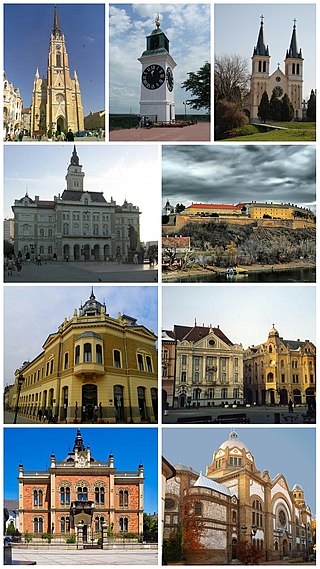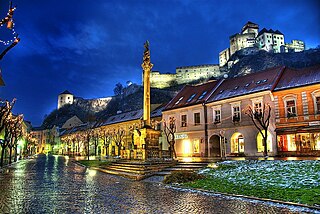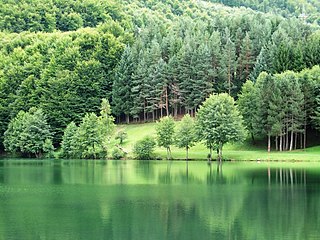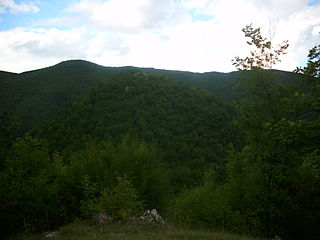
Bled is a town on Lake Bled in the Upper Carniolan region of northwestern Slovenia. It is the administrative seat of the Municipality of Bled. It is most notable as a popular tourist destination in the Upper Carniola region and in Slovenia as whole, attracting visitors from abroad too.

Novi Sad is the second largest city in Serbia after the capital Belgrade and the capital of the autonomous province of Vojvodina. It is located in the southern portion of the Pannonian Plain on the border of the Bačka and Syrmia geographical regions. Lying on the banks of the Danube river, the city faces the northern slopes of Fruška Gora.
Grad or grads may refer to:

Trenčín is a city in western Slovakia of the central Váh River valley near the Czech border, around 95 km (59 mi) from Bratislava. It has a population of more than 55,000, which makes it the eighth largest municipality of the country and is the seat of the Trenčín Region and the Trenčín District. It has a medieval castle, Trenčín Castle, on a rock above the city.

Ulcinj is a town on the southern coast of Montenegro and the capital of Ulcinj Municipality. It has an urban population of 10,707 (2011), the majority being Albanians.

The Belgrade Fortress, consists of the old citadel and Kalemegdan Park on the confluence of the Sava and Danube rivers, in an urban area of modern Belgrade, Serbia. Located in Belgrade's municipality of Stari Grad, the fortress constitutes the specific historical core of the city. As one of the most important representatives of Belgrade's cultural heritage, it was originally protected right after World War II, among the first officially declared cultural monuments in Serbia. The fortress was declared a Monument of Culture of Exceptional Importance in 1979, and is protected by the Republic of Serbia. It is the most visited tourist attraction in Belgrade, with Skadarlija being the second. Since the admission is free, it is estimated that the total number of visitors is over 2 million yearly.
A gord is a medieval Slavonic fortified settlement, usually built on strategic sites such as hilltops, riverbanks, lake islets or peninsulas between the 6th and 12th centuries in Central and Eastern Europe. A typical gord consisted of a group of wooden houses surrounded by a wall made of earth and wood, and a palisade running along the top of the bulwark.

Modriča is a town and municipality of Bosnia and Herzegovina, located in the Republika Srpska entity. As of 2013 census, the town has a population of 10,137 inhabitants, while the municipality has a population of 25,720 inhabitants.

Břeclav is a town in the South Moravian Region of the Czech Republic. It has about 25,000 inhabitants.
Stari Grad is a town on the northern side of the island of Hvar in Dalmatia, Croatia. One of the oldest towns in Europe, its position at the end of a long, protected bay and next to prime agricultural land has long made it attractive for human settlement. Stari Grad is also a municipality within the Split-Dalmatia County.

Mrkonjić Grad is a town and municipality of western Bosnia and Herzegovina, located in the Republika Srpska entity in the region of Bosanska Krajina, between Banja Luka and Jajce. As of 2013, the municipality has a population of 16,671 inhabitants, while the town of Mrkonjić Grad has a population of 7,915 inhabitants.

Stari Grad is a fortress near the city of Užice, in central Serbia. Today in ruins, it is an example of typical medieval Serbian architecture. Historians believe it was built in the second half of the 14th century to control movement along nearby roads, and the town of Užice. Stari Grad was declared Protected Monument of Culture in 1983, and it is protected by Republic of Serbia. Though in ruins, the fortress is considered a symbol of Užice.

Ljubljana Castle is a castle complex standing on Castle Hill above downtown Ljubljana, the capital of Slovenia. It is a key landmark of the town. Originally a medieval fortress, it was probably constructed in the 11th century and rebuilt in the 12th century. It acquired its present outline with an almost complete overhaul in the 15th century, whereas the majority of the buildings date to the 16th and 17th centuries. Initially a defense structure and since the first half of the 14th century the seat of the lords of Carniola, it was since the early 19th century used for various other purposes and today is used as a major cultural venue.
Mrkonjić is a Serbo-Croatian surname. It may refer to:
Fudbalski klub Sloboda Mrkonjić Grad is a football club from the town of Mrkonjić Grad, Republika Srpska, Bosnia and Herzegovina.

Balkana is an artificial lake located on the slopes of Lisina mountain, in the municipality of Mrkonjić Grad, entity of Republika Srpska, in the western part of Bosnia and Herzegovina. The lake, actually, consists of two separate, though connected via small outcomes, basins, upper as larger and lower as smaller, with very small difference in water tables levels. Total area of both basins is 56.000 m2 (602.78 sq ft). Balkana gets its waters from several mountain springs and two small mountain streams, Cjepalo and Skakavac, while its outflow is Crna Rijeka (English: Black River), which runs through Mrkonjić Grad from south to north, and joins Vrbas after 17 km (11 mi).
Operation Southern Move was the final Croatian Army (HV) and Croatian Defence Council (HVO) offensive of the Bosnian War. It took place in western Bosnia and Herzegovina on 8–11 October 1995. Its goal was to help the Army of the Republic of Bosnia and Herzegovina (ARBiH) whose positions around the town of Ključ, captured by them during Operation Sana, were endangered by a counteroffensive by the Army of Republika Srpska (VRS). The objectives of Operation Southern Move included the capture of the town of Mrkonjić Grad and positions on the Manjača Mountain which would allow the HV and the HVO to directly threaten Banja Luka, the largest city controlled by Bosnian Serbs. Finally, the offensive was also aimed at capturing the Bočac Hydroelectric Power Station, the last significant source of electricity under VRS control in western Bosnia and Herzegovina. The combined HV and HVO forces were under the overall command of HV Major General Ante Gotovina.
Donji Baraći is a settlement located in the Municipality of Mrkonjić Grad, of the Republika Srpska Entity in Bosnia and Herzegovina. It used to be a municipality in the Socialist Federal Republic of Yugoslavia until 1963, when it was abolished and incorporated into the Municipality of Mrkonjić Grad.

Sokograd, also known as Pliva or Plivski grad, Pliva-Soko, Sokol-grad, Soko-grad, or simply Soko or Sokol, is a medieval fortress with a castle town in the Pliva river valley, between Gerzovo and nearby Šipovo, in Šipovo municipality, Republika Srpska entity of Bosnia and Herzegovina. It was a very important fortress for the medieval Bosnian state, and the center of the župa Pliva. It was built in a canyon on a steep slope high above the river Sokočnica, which flows into Pliva in Šipovo.
Gornji Baraći is a settlement in Bosnia and Herzegovina, located in the Municipality of Mrkonjic Grad of the Republika Srpska entity.











